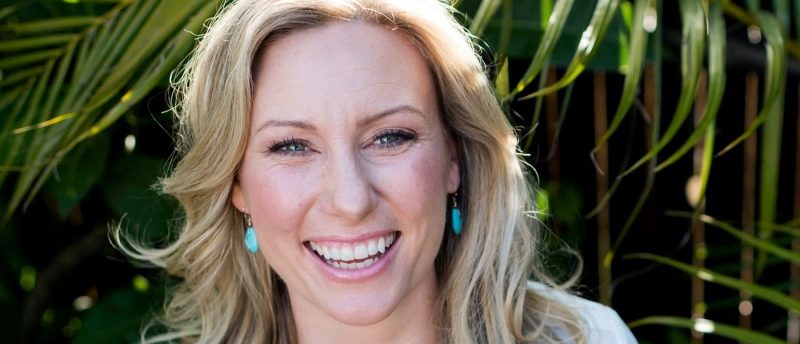In the moments before a yoga teacher was fatally shot by Minneapolis police, a woman slapped the officers’ patrol car while it drove through an alley, according to a search warrant application filed this week.
Though the information in the warrant is vague, it could explain the “loud sound” that reportedly startled Officers Matthew Harrity, the cruiser’s driver, and Officer Mohamed Noor, who was in the front passenger seat, just before Noor shot 40-year-old Justine Damond. Harrity described the noise to investigators.
[Timeline of Justine Damond shooting]
The warrant to search the area near the incident, obtained by several local media outlets, does not specify whether the woman who reportedly slapped the car was also the shooting victim, 40-year-old Australian native Damond.
Damond, who moved to Minneapolis in 2015 to be with her fiancee, was killed just before midnight on July 15 — an incident still shrouded in mystery because the investigating agency, the Minnesota Bureau of Criminal Apprehension, has released few details and it was not captured on camera.
“Upon police arrival, a female ‘slaps’ the back of the patrol squad,” according to the search warrant filed by the BCA, reported MPR News. “After that, it is unknown to BCA agents what exactly happened, but the female became deceased in the alley.”
The two had responded to 911 calls from Damond at around 11:30 p.m. reporting a possible sexual assault in the alley behind the woman’s home in a nice Minneapolis neighborhood. Damond, according to the 911 transcripts, called when she heard a woman either having sex or being raped, The Washington Post previously reported.
“I think she just yelled out ‘help,’ but it’s difficult,” Damond said, according to a police transcript of the call.
Damond called again eight minutes later when authorities still hadn’t arrived, worried they had gone to the wrong address.
[Australian woman fatally shot by Minneapolis police called 911 twice to report hearing a possible rape]
It’s unclear what exactly happened next, but Harrity told BCA investigators that Damond approached his side of the vehicle right after the loud noise. Noor, sitting in the passenger seat, fired his gun across his partner’s body and through the driver’s side window, striking Damond in the abdomen.
The officers attempted CPR, but 20 minutes after she called 911, Damond was dead.
Authorities found no weapons at the scene.
There has been international outcry in the weeks since, prompting rallies in Minnesota, beachside vigils from Damond’s family in Australia and the resignation of the Minneapolis police chief over concerns that her officers — including Noor and Harrity — had not been properly trained.
Noor has declined to speak with BCA investigators, but an attorney for Harrity, Fred Bruno, hinted in an interview with the Minneapolis Star Tribune last week that the officers may have believed they were being ambushed.
“It’s certainly reasonable to assume that any police officer would be concerned about a possible ambush under these circumstances,” Bruno told the Star Tribune.
A fake street sign is mounted on the same pole as legitimate ones at a Minneapolis intersection on July 23. (Erin Adler/Star Tribune via AP)
Last weekend, several bright orange metal signs appeared in the Minneapolis region, bolted to already existing street signs with a message mocking Harrity’s “startled” comment: “WARNING: TWIN CITIES POLICE EASILY STARTLED.”
The signs featured a cartoon police officer with guns in both hands, firing in opposite directions. The signs were later removed.
The signs were just one of several acts of protest in the weeks since Damond’s death. The day after she died, hundreds of neighbors, community members, political candidates and police reform advocates gathered outside Damond’s home to celebrate her life and demand transparency from police.
Officials, including Minneapolis Mayor Betsy Hodges, were quick to condemn the lack of video evidence from the shooting. Both officers wore body cameras but never turned them on, and the dash camera on the patrol did not capture the incident.
That fueled outrage from community members and groups like Black Lives Matter, which advocated for police body cameras to prevent the mystery that often accompanies officer-involved shootings with conflicting narratives. The Twin Cities region was already jarred by two other fatal police shootings of black men from the area, Philando Castile and Jamar Clark.
In his first interview since Damond was killed, Don Damond, the man she was to marry in August, told the New York Times last week that he initially thought it was the alleged rapist who had shot her. Justine had called him that night when she heard the screams outside. From inside a casino in Las Vegas, he told her to call 911.
Once police arrived, they hung up, Don Damond told the Times. He told her to call him back, but the rest of the night his texts went unanswered.
“I have played this over in my head over and over,” Damond told the Times. “Why didn’t I stay on the phone with her?”





 02 p.m.
02 p.m.
Comment